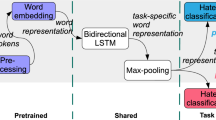Abstract
This paper presents a novel multimodal model that integrates both image and large language model capabilities to enhance hate intensity prediction, traditionally a purely text-based task. Accurately assessing hate speech intensity is crucial for moderating and regulating vast online communities by normalizing hate speech [1], while ensuring a balance between free expression and responsible communication. Our approach leverages insights from both the visual and language domains, resulting in the novel Multimodal Model for Hate Speech (MMHS). We demonstrate that MMHS achieves state-of-the-art performance on the NACL dataset, surpassing previous benchmarks by scoring 0.350 lower in Root Mean Squared Error (RMSE) and 0.132, and 0.012 higher in Pearson, and Cosine metrics, respectively. Additionally, user preference surveys indicate a significant favoring of our predictions over those of Masud et al. [1] by 16.67%. This work advances the technical landscape of hate speech detection and enriches our understanding of online discourse, enabling more effective moderation strategies. (Disclaimer: This paper includes examples of hate speech which contain some profane words. These examples are only included for contextual understanding. We tried our best to censor vulgar, offensive, or hateful words. We assert that we do not support these views in any way.)
A. Goel and A. Poswal—Contributed equally to this work.
Access this chapter
Tax calculation will be finalised at checkout
Purchases are for personal use only
Similar content being viewed by others
References
Masud, S., et al.: Proactively reducing the hate intensity of online posts via hate speech normalization. In: Proceedings of the 28th ACM SIGKDD Conference on Knowledge Discovery and Data Mining (KDD) 3524–3534 (2022)
Awan, I., Zempi, I.: The affinity between online and offline anti-Muslim hate crime: dynamics and impacts. Aggression Violent Behav. 27, 1–8 (2016). https://doi.org/10.1016/j.avb.2016.02.001
Lupu, Y., et al.: Offline events and online hate. PLos One 18(1), e0278511 (2023). https://doi.org/10.1371/journal.pone.0278511
Wiedlitzka, S., et al.: Hate in word and deed: the temporal association between online and offline islamophobia. J. quant. Criminol. (2023)
Hee, M.S., et al.: Recent advances in hate speech moderation: multimodality and the role of large models. arXiv preprint (2024)
Radford, A., et al.: Learning transferable visual models from natural language supervision. In: Proceedings of the 38th International Conference on Machine Learning, ICML 2021, pp. 8748–8763 (2021)
Touvron, H., et al.: LLaMA: open and efficient foundation language models. arXiv preprint (2023)
Jiang, A.Q., et al.: Mistral 7B. arXiv preprint (2023)
Gemini Team, et al.: Gemini: a family of highly capable multimodal models. arXiv preprint (2024)
Liu, Y., et al.: RoBERTa: a robustly optimized BERT pretraining approach. arXiv preprint (2019)
Waseem, Z., Hovy, D.: Hateful symbols or hateful people? Predictive features for hate speech detection on Twitter. In: NAACL SRW, pp. 88–93 (2016). https://doi.org/10.18653/v1/N16-2013
Founta, A.-M., et al.: Large scale crowdsourcing and characterization of Twitter abusive behavior. In ICWSM (2018)
ElSherief, M., et al.: Latent hatred: a benchmark for understanding implicit hate speech. In: EMNLP, pp. 345–363 (2021). https://doi.org/10.18653/v1/2021.emnlp-main.29
Kennedy, B., et al.: The gab hate corpus: a collection of 27k posts annotated for hate speech. In: PsyArXiv (2018)
Kiela, D., et al.: The hateful memes challenge: detecting hate speech in multimodal memes. In: NeurIPS (2020)
Wu, C., Bhandary, U.: Detection of hate speech in videos using machine learning. In: International Conference on Computational Science and Computational Intelligence. IEEE (2020)
Barakat, M.S., et al.: Detecting offensive user video blogs: an adaptive keyword spotting approach. In: ICALIP, pp. 419–425 (2012). https://doi.org/10.1109/ICALIP.2012.6376654
Wazir, A., et al.: Spectrogram-based classification of spoken foul language using deep CNN. In: MMSP (2020)
Boishakhi, F., et al.: Multi-modal hate speech detection using machine learning. In: Big Data. IEEE (2021)
Cao, R., Lee, R.: HateGAN: adversarial generative-based data augmentation for hate speech detection. In: COLING (2020)
Brown, T.B., et al.: Language models are few-shot learners. arXiv preprint (2020)
Huang, Z., et al.: Bidirectional LSTM-CRF models for sequence tagging. arXiv preprint (2015)
Basile, V., et al.: SemEval-2019 task 5: multilingual detection of hate speech against immigrants and women in Twitter. In: Proceedings of the 13th International Workshop on Semantic Evaluation (SemEval) (2019)
Chung, Y., et al.: CONAN - COunter NArratives through Nichesourcing: a multilingual dataset of responses to fight online hate speech. In: Proceedings of the 57th Annual Meeting of the Association for Computational Linguistics. Association for Computational Linguistics, Florence, Italy, pp. 2819–2829 (2019). https://doi.org/10.18653/v1/P19-1271
Davidson, T., et al.: Racial bias in hate speech and abusive language detection datasets. In: Proceedings of the Third Workshop on Abusive Language Online, Florence, Italy, pp. 25–35 (2019)
Gibert, O., et al.: Hate speech dataset from a white supremacy forum. In: ALW, pp. 11–20 (2018)
Jha, A., Mamidi, R. : When does a compliment become sexist? Analysis and classification of ambivalent sexism using twitter data. In: Proceedings of the Second Workshop on NLP and Computational Social Science, Vancouver, Canada, pp. 7–16 (2017)
Mathew, B., et al.: HateXplain: a benchmark dataset for explainable hate speech detection. Proc. AAAI Conf. Artif. Intell. 35(17), 14867–14875 (2021)
van der Maaten, L., Hinton, G.: Viualizing data using t-SNE. JMLR, 2579–2605 (2008)
Acknowledgments
This work is based on sensitive material so we would like to thank our human participants in our survey. (The authors have no conflicting interests related to the scope of this article.)
Author information
Authors and Affiliations
Corresponding author
Editor information
Editors and Affiliations
Rights and permissions
Copyright information
© 2025 The Author(s), under exclusive license to Springer Nature Switzerland AG
About this paper
Cite this paper
Goel, A., Poswal, A. (2025). MMHS: Multimodal Model for Hate Speech Intensity Prediction. In: Karpov, A., Delić, V. (eds) Speech and Computer. SPECOM 2024. Lecture Notes in Computer Science(), vol 15300. Springer, Cham. https://doi.org/10.1007/978-3-031-78014-1_8
Download citation
DOI: https://doi.org/10.1007/978-3-031-78014-1_8
Published:
Publisher Name: Springer, Cham
Print ISBN: 978-3-031-78013-4
Online ISBN: 978-3-031-78014-1
eBook Packages: Computer ScienceComputer Science (R0)




